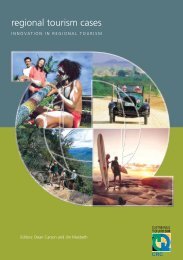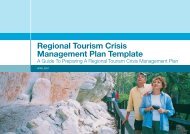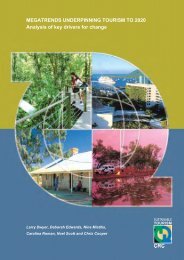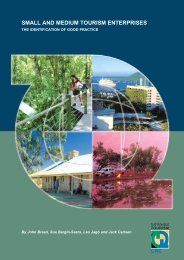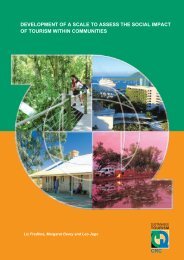Tourism Risk Management - Sustainable Tourism Online
Tourism Risk Management - Sustainable Tourism Online
Tourism Risk Management - Sustainable Tourism Online
You also want an ePaper? Increase the reach of your titles
YUMPU automatically turns print PDFs into web optimized ePapers that Google loves.
CHAPTER 2: RISK MANAGEMENT FOR TOURISM CRISES AND<br />
DISASTERS<br />
Aim of this Chapter<br />
The aim of this chapter is to provide background on the formal government disaster management<br />
processes for communities and to identify and examine issues of risk management which are<br />
relevant to the tourism industry and tourism operators.<br />
In this manual, risk management is concerned with identifying and analysing the risks (the chance of<br />
something happening) to an organization or community and deciding what can or should be done to<br />
address these risks. An official definition of risk management is: ‘the culture, processes and<br />
structures that are directed towards realizing potential opportunities whilst managing adverse effects’<br />
(Australian Standards Association/New Zealand Standards Association, 1995).<br />
<strong>Risk</strong> management in the tourism context refers to the planning and implementation of processes<br />
directed towards managing the adverse effects of crises and disasters on tourism. It also addresses<br />
tourism’s potential opportunities for the improvement in systems and procedures. This chapter<br />
addresses risk management for tourism destinations and individual tourism businesses and<br />
organizations.<br />
Introduction<br />
The Asian Disaster Preparedness Centre in Bangkok defines disaster as: ‘the serious disruption of<br />
the functioning of society causing widespread human, material, or environmental losses which<br />
exceed the ability of the affected communities to cope using their own resources’. In Carter’s manual<br />
for disaster managers funded by the Asian Development Bank, disaster is defined as: ‘an event;<br />
natural or man-made, sudden or progressive, which impacts with such severity that the affected<br />
community has to respond by taking exceptional measures’ (Carter, 1992). The World Health<br />
Organization’s definition of disaster is: ‘any occurrence that causes damage, economic disruption,<br />
loss of human life and deterioration in health and health services on a scale sufficient to warrant an<br />
extraordinary response from outside the affected area or community’.<br />
The common thread in these and other definitions of disaster is that there is disruption to the<br />
community which is of such magnitude that responding organizations, infrastructure and resources<br />
are overwhelmed, and there is an inability to return to normal without external assistance.<br />
For disaster management purposes, an appropriate and practical definition is one which recognizes<br />
the severity of the effects of a disaster, its impact upon a community, and the required level of<br />
response. In the Australian Emergency <strong>Management</strong> Glossary (EMA, 2006) disaster is defined as: ‘a<br />
serious disruption to community life which threatens or causes death or injury in that community<br />
and/or damage to property which is beyond the day-to-day capacity of the prescribed statutory<br />
authorities and which requires special mobilization and organization of resources other than those<br />
normally available to those authorities’.<br />
Regardless of the definition used, it is important to realize that disasters are different in kind and in<br />
scope from day-to-day emergency incidents. Disasters are not simply bigger events; they have a<br />
significant impact upon people and their infrastructure and community resources; they inevitably<br />
overwhelm the capacity of the community and the resources and facilities available for management<br />
of the immediate response, and they produce long-term problems of restoration and rehabilitation.<br />
Disasters are not over when the flood waters have receded, when the injured have been treated, or<br />
the bodies cleared away. The community has to be put back together: and the community includes<br />
the people, their infrastructure, and resources.<br />
16 <strong>Tourism</strong> <strong>Risk</strong> <strong>Management</strong> – An Authoritative Guide to Managing Crises in <strong>Tourism</strong>



